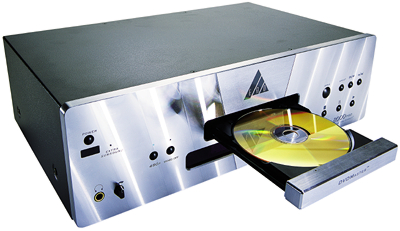EAD DVDMaster 8000 Pro DVD player

Keeping up with the rapid advances in home theater is a big job even for large, well-funded corporations; it's even harder for a small company to find the cash to finance serious R&D. But TARA Labs, a leading manufacturer of high-performance cables and accessories, saw EAD's promise. TARA bought EAD and set up a new company, Alpha Digital Technologies, with EAD as its brand name, and moved EAD to TARA's home base in Ashland, Oregon. The infusion of capital, production expertise, and marketing muscle revitalized EAD, making possible an entirely new lineup of high-end home-theater products, including the DVDMaster 8000 Pro DVD player.
Guts 'n' Glory
With so many fine mainstream DVD players available for under $1000, a $5900 model must deliver substantially higher performance as well as lots of features. EAD attempts to justify the DVDMaster 8000 Pro's price with a combination of high-end style and an ambitious set of operating parameters. As befits its high-end pedigree, the markings and buttons on the 8000 Pro's faceplate are minimal, reserving a substantial slice of real estate for its glistening finish. Over the years, EAD gear developed a signature appearance based on shiny silver faceplates textured to create iridescent rainbow reflections. Jeff Rowland, of the Jeff Rowland Design Group, pioneered this finish, but EAD has exploited it to its full potential. Visually, the DVDMaster's glossy, 1/2-inch-thick faceplate immediately separates it from any under-$1000 DVD player on the market.
The 8000 Pro is based on a Panasonic chassis, so you might suspect it to be little more than a tarted-up Panasonic. Suspect again. Just as the Meridian 596 DVD player used a computer's ROM drive because it was ideally suited to the purpose, EAD chose a Panasonic DVD player because it offers the best starting point for their new design.
EAD makes two versions of the DVDMaster: the 8000 ($4500) and the 8000 Pro. The 8000 provides its progressive component output courtesy of the Genesis chip designed into the source Panasonic chassis. The Genesis's extensive adjustment features include contrast, brightness, high sharpness, V sharpness, edge sharpness, tint, color saturation, gamma, 3D video noise reduction, block-noise reduction, mosquito-noise reduction, transfer mode, shift position, and sepia, monochrome, and negative (reversed) image capabilities. An aspect-ratio control pre-squeezes the image to allow proper display of non-anamorphic program material on televisions that lock into anamorphic mode when they receive a progressive input. A Video Off mode disables the video circuits for audio-only playback. Seems like the only feature left out is a cold-fusion generator.
The Pro retains the Genesis chip and its outputs, but also bypasses it with an upscale deinterlacing option, EAD's Adagio video circuit. This proprietary board is based on a Silicon Image 503 chip and ADV 7122 triple video DAC and employs mil-spec components. It gets its video signal directly from the digital output of the player's MPEG decoder. EAD makes much of this direct connection in their literature, even giving it a name—Direct Digital Feed. But all progressive-scan DVD players that we know of use a direct digital feed between the MPEG decoder and deinterlacing circuitry, with the only video digital-to-analog conversion taking place at the output stage. The Adagio board bypasses most of the video controls provided by the Genesis chip, retaining only aspect-ratio control and the Video Off mode.
The Adagio board on the DVDMaster 8000 Pro provides the option of RGBHV outputs. These are available from a 15-pin VGA connector. The latter may also be switched to provide a component (Y-Pr-Pb) feed, with component (only) also available from three RCA jacks.
You could, if so inclined, build a surround-sound system sans processor by using the DVDMaster as your sole signal source. Both the DVDMaster 8000 and the DVDMaster 8000 Pro share the same multi-level, delta-sigma, 24-bit/192kHz Burr-Brown DACs, premium-quality analog volume control with a switched resistive array, and exceptional audio output capabilities. Adapters are provided to convert the balanced XLR jacks used for all of EAD's upgraded audio outputs to RCA jacks, for those who prefer (or must use) single-ended connections. Both players accommodate all current DVD- and CD-based formats (apart from SACD, unfortunately), and include onboard Dolby Digital and DTS decoders. One of the outputs can feed a center surround speaker with a Dolby Surround EX- and DTS ES (matrix)-compatible signal. There are two subwoofer outputs, but although they are labeled Left and Right, both provide the same mono sub signal. And their firmware is updatable via an RS-232 RJ-11 connector.
With its MultiBass system, EAD builds bass management into both DVDMaster models. Bass management is also available for DVD-Audio. The DTS/DVD-Audio 5.1-channel mode combines a 100Hz crossover highpass for Small speakers with a second-order lowpass filter for the subwoofer. There's also a DVD-Audio mode (DVD-A 6.0 flat), in which all channels receive full-range signals. This mode can be used with either standard DVD-Audio releases or with Chesky Records' unconventional 6.0-channel setup (L/R front, L/R sides, L/R rear—no center or subwoofer). Level trims are provided for all bass-management modes, but channel-delay adjustments are available only for Dolby Digital.
Considering the 8000 Pro's cost, the remote control is underwhelming. While I've experienced much worse remotes, EAD's lacks the solid feel and definitive looks of the best high-end controls. While appropriate for a $1000 player, the DVDMaster deserves better. You can tell the remote's top from its bottom in the dark, and you don't need a flashlight to make it work, but, overall, it doesn't garner a ton of style points.













































